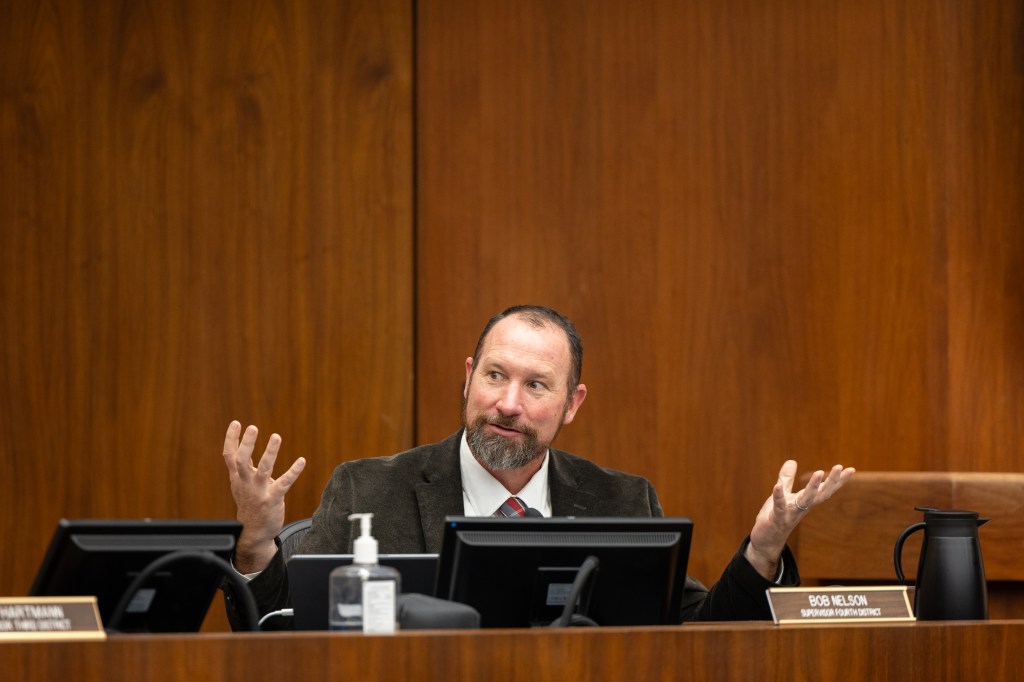Sheriff Brown Seeks Funding for New $3.3M Narc Unit as Drug Deaths Soar
Brown Gives Report on County's Fentanyl-Driven Spike in Overdose Deaths, Requests Funding

Sheriff Bill Brown detailed, with a somber gravitas this past Tuesday afternoon, the death toll inflicted on Santa Barbara County by drug overdoses these past three years. The county supervisors, before whom he was making his pitch, were undeniably moved; the carnage — 539 overdose deaths from 2021 to 2023 — has been truly horrific.
But they were also not saying yes to what Brown most wanted to hear: yes to a $3.3 million budget request that would fund an additional narcotics investigation unit for his department over the next three years. But then, they didn’t exactly say no, either. By the meeting’s end, Brown was visibly frustrated.
Right now, the Sheriff’s Office has a five-person team of full-time narcotics investigators. And those five, Brown stressed, are the only full-time narcotics investigators in all of Santa Barbara County. None of the other seven law enforcement agencies has a single full-time narcotics investigator.
Back in 2007, Brown noted, there were 27 full-time investigators assigned to the narcotics details of the county’s eight law enforcement agencies. And in that year, Brown noted, Santa Barbara had just 33 overdose deaths. In 2023, by contrast, that number had jumped to 226.
To drive home the magnitude of the problem, Brown flashed a photo of the stone plaque outside the Veterans Memorial Building on Cabrillo Boulevard bearing the engraved names of all Santa Barbara service members killed in all the United States’ wars over the past 163 years. On that plaque, he said, there were 493 names. “Think about this for a moment,” he challenged the supervisors: 493 in the last 163 years compared to 539 in the past three years, all from drug overdoses.
Brown’s report came just one week before the supervisors are scheduled to begin preliminary discussions about this year’s budget. The news going in is not good. There will be less money coming from Sacramento. Money will be tight this year. Despite Brown’s impassioned performance, what many of the five supervisors wanted to know was where this money was supposed to come from.

And more importantly, why they should increase funding for more narcotics investigators if none of the police departments in the county were paying for even one single narcotics investigator. Third District Supervisor Joan Hartmann said she would be more open to Brown’s idea if other law enforcement agencies demonstrated a willingness to step up.
Brown answered that many of the other agencies were simply too small to afford the commitment; some he said were already 25 percent understaffed, and it wasn’t realistic to expect cash strapped agencies — with less than 50 officers — to bridge the gap. Though Brown was willing to cut back a little, suggesting the supervisors might fund the proposal for only two years instead of three, he warned that if they didn’t step up at all, people would die at an alarming rate. “It’s the right thing to do,” he said.
To highlight his point, he described how his department’s investigators had seized seven pounds of fentanyl and 22 pounds of methamphetamine in the past year. That, he said translated to 31,780 doses of fentanyl and 100,320 doses of meth. Each dose, he cautioned, was potentially fatal. “Scores of lives were saved,” he said.
According to the Sheriff’s report, the number of drug overdose deaths continued their dramatic upward ascent between 2021 and 2023, driven largely by a spike in fentanyl deaths. Overall, drug overdose of any kind climbed from 149 in 2021 to 226 in 2023. Fentanyl-related fatalities jumped from 78 to 112 in that same time period.
Although there was an uptick in the number of deaths for women, Latinos, and homeless people, most of the overdose deaths — either by fentanyl or other substances — involved housed white males between the ages of 35 and 54. Conversely, the most significant drop took place with people between the ages of 18 and 34. In 2021, this age group accounted for 33.6 percent of all overdose deaths and by 2023, that number dropped to 19 percent. For fentanyl, the drop was more precipitous, from 50 percent in 2021 to 25 percent in 2023.

Perhaps the most striking statistic was that 70 percent of all overdose deaths during a five-month period in 2023 involved individuals who had previously been incarcerated in county jail. Supervisor Hartmann noted this number underscored the importance of funding jail-based drug rehab programs involving methadone.
Hartmann also pressed Brown as to why his Project Opioid — made up of high-profile movers and shakers in the world of industry, health, and education — was not collaborating more actively with members of the Santa Barbara Opioid Safety Commission, made up of people in the trenches of drug rehab, prevention, harm reduction, and education. Project Opioid membership was by invitation only and the Safety Commission was open to anyone who wanted to participate. More collaboration, Hartmann stressed, was needed. “It could be a little tighter,” she observed.
Supervisor Bob Nelson, perhaps the board’s most outspoken fiscal conservative, said that there were 110 open vacancies positions in the Sheriff’s Office. He questioned what impact the addition of five new investigators could make? These are funded positions, Nelson noted with some impatience. “We’ve got to fill the rest of these too.” Brown retorted that there were only 16 vacancies among sheriff’s deputies. The bulk of the unfilled positions were correctional deputies in the jail. When Nelson questioned why the positions of 10 recent retirees hadn’t already been filled, Brown shot back that his HR department had been doing “a yeoman’s job.”
The debate is far from over; it will resume next week during the budget workshops, though with less dramatic flourish and fanfare.

Premier Events
Thu, May 02
5:00 PM
Santa Barbara
Things with Wings at Art & Soul
Sat, May 04
10:00 AM
Lompoc
RocketTown Comic Con 2024
Thu, May 02
5:00 PM
Santa Barbara
100th Birthday Tribute for James Galanos
Thu, May 02
5:00 PM
Santa Barbara
Meet the Creator of The Caregiver Oracle Deck
Fri, May 03
4:00 PM
Santa Barbara
Santa Barbara Fair+Expo “Double Thrill Double Fun”
Fri, May 03
8:00 PM
Santa barbara
Performance by Marca MP
Sat, May 04
10:00 AM
Solvang
Touch A Truck
Sat, May 04
11:00 AM
Santa Barbara
Mental Wellness Center’s 28th Annual Arts Faire
Sat, May 04
11:00 AM
Santa Barbara
Community History Day
Sat, May 04
3:00 PM
Solvang
The SYV Chorale Presents Disney Magic Concert
Sat, May 04
7:00 PM
Santa Barbara
A Star Wars Cantina Celebration: Renegades, Rebels, and Rogues
Tue, May 07
7:00 PM
Santa Barbara
Theatre Eclectic Presents “The Great Gatsby” – Wake Auditorium
Thu, May 02 5:00 PM
Santa Barbara
Things with Wings at Art & Soul
Sat, May 04 10:00 AM
Lompoc
RocketTown Comic Con 2024
Thu, May 02 5:00 PM
Santa Barbara
100th Birthday Tribute for James Galanos
Thu, May 02 5:00 PM
Santa Barbara
Meet the Creator of The Caregiver Oracle Deck
Fri, May 03 4:00 PM
Santa Barbara
Santa Barbara Fair+Expo “Double Thrill Double Fun”
Fri, May 03 8:00 PM
Santa barbara
Performance by Marca MP
Sat, May 04 10:00 AM
Solvang
Touch A Truck
Sat, May 04 11:00 AM
Santa Barbara
Mental Wellness Center’s 28th Annual Arts Faire
Sat, May 04 11:00 AM
Santa Barbara
Community History Day
Sat, May 04 3:00 PM
Solvang
The SYV Chorale Presents Disney Magic Concert
Sat, May 04 7:00 PM
Santa Barbara
A Star Wars Cantina Celebration: Renegades, Rebels, and Rogues
Tue, May 07 7:00 PM
Santa Barbara


























You must be logged in to post a comment.